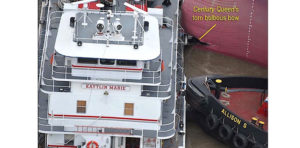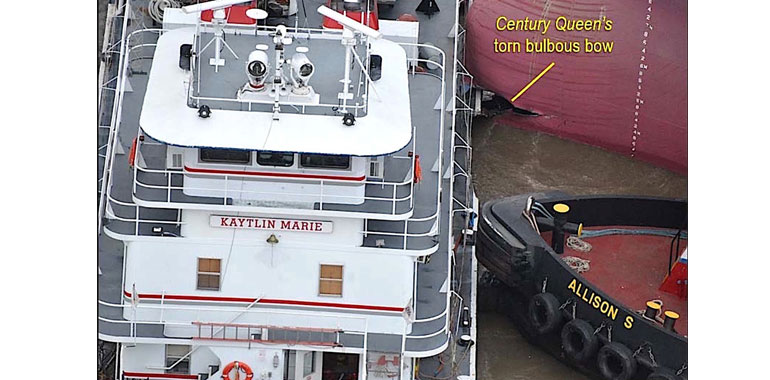
The lack of “early and effective communication” led to the collision of a bulk carrier and towboat during a passing maneuver on the Lower Mississippi River, injuring three mariners and causing a fuel spill, according to National Transportation Safety Board (NTSB) investigators.
The upbound bulker Century Queen, with a crew of 21, and the downbound towboat Kaytlin Marie, with seven crewmembers, collided at 1215 on June 8, 2019 at mile 126 near Hahnville, La. Three injuries were reported aboard Kaytlin Marie, which was breached and spilled an estimated 8,954 gallons of diesel into the river. Damage to both vessels totaled nearly $1.4 million.
The bulbous bow of the 449-foot Century Queen struck the 126-foot Kaytlin Marie amidships at about a 90-degree angle. The towboat’s No. 4 and No. 5 port fuel tanks were ruptured and the cover of the port aft slop tank was dislodged, releasing an unknown amount of waste oil. The engine room was at risk of flooding through an open starboard door, the NTSB reported. Century Queen’s bow sustained a gash approximately 6 feet long.
Kaytlin Marie’s pilot, who was alone in the wheelhouse at the time of collision, was pinned down by dislodged furniture. Four refrigerators in the galley broke free from the port bulkhead, slid across the mess deck and trapped two deck hands, one of whom suffered internal injuries. The other mariner sustained a minor injury. The nearby towboat Okaloosa rescued the crew of Kaytlin Marie while other Good Samaritan vessels freed the towboat from Century Queen’s bow.
The sequence of events leading up to the accident began at about 1035, when a pilot from the New Orleans-Baton Rouge Steamship Pilots Association (NOBRA) boarded the anchored Century Queen at mile 114. About 30 minutes later, the ship weighed anchor and headed upriver to load rice in Reserve, La. The current was moving at about 4.6 knots; the sky was clear with light winds.
At about 1142, Kaytlin Marie dropped off two empty barges in LaPlace, La., at mile 132. The captain then headed downriver without a tow and was relieved by the pilot for the 1200-1800 watch. En route to Waggaman, La., at mile 110, Kaytlin Marie followed about a half mile and five minutes behind the towboat Repentance, which was pushing one barge. Both vessels favored the left descending bank before approaching the bend at Hahnville.
At 1208 the operator on Repentance called the pilot on Century Queen by radio and the two agreed to a starboard-to-starboard passage. Vessel Traffic Service (VTS) and Century Queen’s voyage data recorder (VDR) captured the conversation.
At about 1209, Kaytlin Marie made a course change to starboard, heading across the river toward the right descending bank. Four minutes later, Repentance and Century Queen passed starboard to starboard.
After passing Repentance at 1213:40, Century Queen’s pilot ordered the rudder to port 5 degrees. Kaytlin Marie had altered course to starboard another 10 degrees in the previous minute. The two vessels were headed almost directly at each other.
At 1214:03, Century Queen’s pilot gave another port 10-degree rudder command, and 22 seconds later the first radio contact took place between the bulk carrier and Kaytlin Marie. Century Queen’s pilot called the towboat regarding passing arrangements. At this point, the vessels were about a half-mile apart and the towboat’s heading hadn’t changed.
The pilot on Kaytlin Marie answered the radio call but didn’t respond to the proposed passing agreement. He told investigators it was the first time he realized that Century Queen intended a starboard-to-starboard passage. He added it was standard procedure for downbound vessels to have the right of way.
The NTSB said Kaytlin Marie’s pilot was “unwilling to turn to port across the ship’s bow as requested” and instead made an evasive maneuver that increased his turn to starboard.
“In his efforts to avoid the collision, however, he did not communicate this intention to Century Queen,” the report said. “By not replying to the ship’s proposal or indicating his intention or inability to meet the request, the pilot aboard the bulker lacked information regarding the towboat’s intentions and came further to port, exacerbating the situation.”
Century Queen increased port rudder to 20 degrees until 1214:58, when the pilot on the bulk carrier gave a “midship” command, followed immediately by “stop engines” and “hard starboard.”
About 10 seconds later, the two vessels collided. During a review of the recorded audio, neither Century Queen’s VDR nor VTS captured a conversation that the pilot aboard the ship said he had attempted about three to five minutes before the crash. He told investigators that although he did not use the radar, Kaytlin Marie’s automatic identification system was easily seen on his display.
The NTSB concluded that as the downbound vessel, Kaytlin Marie was obligated to propose the passing arrangement.
“Early communication by either vessel would have ensured what should have been a safe starboard-to-starboard passing within a half-mile-wide section of the river,” the report said. “The local custom of light boats (no barges in tow) not calling to propose passage when required, or others not calling light boats when in doubt, created a dangerous scenario.”
Repeated phone calls to NOBRA and Integrity Marine Management, the operator of Kaytlin Marie, were not returned.
Damage to the Panama-flagged Century Queen, operated by Hiong Guan Navegacion Japan, was estimated at $383,990. Damage to Kaytlin Marie totaled $991,208.
Eric Colby

